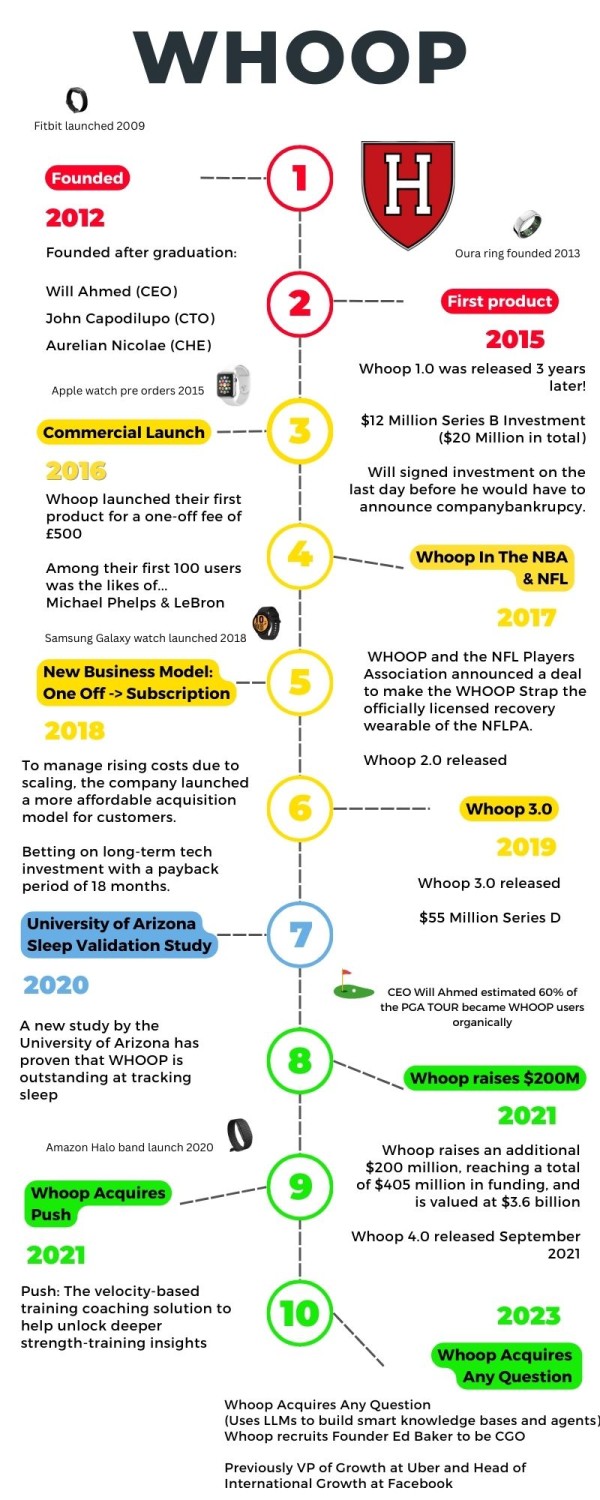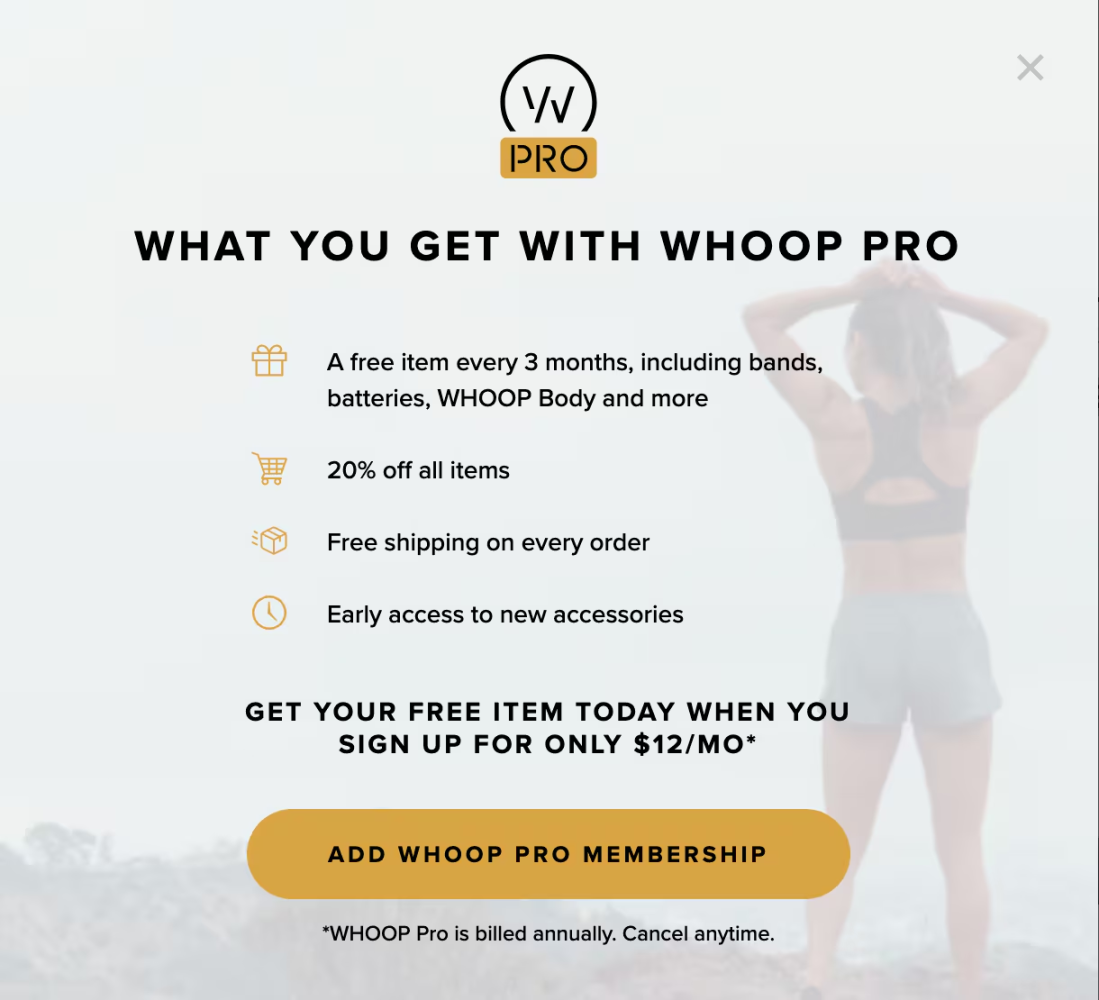Whoop
The Best Obsess
"We believe everyone has an inner potential. A potential to perform at their highest level. We believe this potential can be harnessed by uncovering secrets your body is trying to tell you."
In 2012, Will Ahmed, a Harvard University student athlete, founded the company, stylised as WHOOP, to help athletes gain greater visibility into their own fitness and rest. At the time he wrote a paper “The Feedback Tool: Measuring Intensity, Recovery, and Sleep.”
Along with two fellow students at Harvard, John Capodilupo and Aurelian Nicolae, he incubated a prototype at Harvard Innovation Labs. In 2021 the company raised $200 million from SoftBank’s venture capital fund, with a valuation of $3.6 billion.
Growth Market
The US dominates the global wellness economy, commanding a staggering $1.8 trillion—over twice the size of China’s market. Within this thriving $5.6 trillion global market, the US leads in nearly every sector, showcasing a dramatic shift towards health and lifestyle optimisation.
The fitness tracker market grew to $47.65 billion in 2023, and to $57.77 billion in 2024, marking an impressive 21.2% growth. This surge is fuelled by heightened health awareness, broader integration of wellness in insurance and corporate sectors, and a cultural shift towards preventative health.
Additionally, the sleep economy is booming, projected to hit $585 billion in 2024, driven by increasing public awareness of sleep’s essential role in health, backed by rising investments in sleep technology.
Human Performance
“Our mission is to unlock human performance”
“We’re revolutionising the way that people understand their bodies. WHOOP provides unprecedented visibility into the relationship between physiology and performance, helping people reach their highest potential physically, mentally, and emotionally.”
“WHOOP doesn’t count steps—instead measuring only the metrics scientifically proven to make a significant impact on your physical and mental health. WHOOP outperforms other leading wearables, delivering over 99% heart rate and HRV tracking accuracy and gold-standard sleep tracking, making it one of the most powerful, most accurate, and most wearable human performance tools you can buy.”
- WHOOP collects a lot of personal fitness data on its users, on the order of 50MB-100MB per day, which is 1,000x-10,000x the quantity collected by a Fitbit/Apple Watches.
- Proprietary algorithms: WHOOP monitors strain, recovery, and sleep using proprietary algorithms based on Heart Rate Variability (HRV), the variation in time between each heartbeat, as well as four other variables tracked 100 times per second
- WHOOP In-house research lab: “WHOOP is the only wearable in the game that has a dedicated research facility that empowers its own members to influence product features and be a part of groundbreaking discoveries about health and performance. When you participate, you are eligible for free months on WHOOP or select gift cards.”

Wearable Metrics
WHOOP developed a wearable device that tracks metrics like sleep, recovery, and strain.
The first version, WHOOP 1.0, was released in 2015, followed by several iterations, with the latest being WHOOP 4.0 in 2021. Ahmed has always refused to add a screen to WHOOP as a conscious design choice as it increases the perception of its “scientific” effectiveness.
WHOOP operates on a subscription-based model. Instead of charging for the hardware, WHOOP provides the device for free and charges a monthly fee for access to the WHOOP app, where users can view and analyze their data. This model allows WHOOP to focus on providing value through software and analytics.
WHOOP has introduced several innovative features over the years:
- WHOOP Coach: A personalized health and fitness coaching feature powered by OpenAI.
- Stress Monitor: Tracks daily stress levels through heart rate variability and resting heart rate.
- WHOOP Live: Integrates WHOOP data into live sports broadcasts.
- Battery Technology: WHOOP 4.0 features a battery developed by Sila Nanotechnologies that increases battery capacity.
“WHOOP Coach takes proprietary WHOOP algorithms, a custom-built machine learning model, the latest in performance science and research, and your unique biometric data to identify patterns and connections in your WHOOP data. With OpenAI’s latest technology, WHOOP Coach generates highly individualized, conversational responses to your health, fitness, and wellness questions – all within seconds.”
Business Model
At its commercial debut in late 2016, WHOOP initially priced its devices at one-time fee of $500, with production costs ranging between $250-$300 per unit..
As production scaled and costs declined coupled with observing user retention over extended periods, specifically low churn in those extended customer lifetimes, CEO Will Ahmed recognised the strategic advantage of transitioning to a subscription model as there was revenue there to be made.
Inspired by the market performances of Fitbit and Peloton, Ahmed saw the substantial value investors assigned to subscription models over one-time hardware sales, prompting WHOOP to adopt a similar approach.

Now, WHOOP focuses on “keeping your customers every day,” a strategy that demands constant innovation and the addition of immediate value. The move to a subscription model means Whoop must “release new features that are adding value now,” ensuring customer retention and satisfaction daily.
This deeper focus has intensified strategic discussions within WHOOP, making every feature development decision a step towards enhancing their customer-centric mission and strengthening their competitive advantage. By embedding a relentless pursuit of innovation in its DNA, WHOOP not only sustains its subscriber base but also drives its market leadership.
The Best Obsess
WHOOP’s ad campaign “The Best Obsess” features athletes and business thinkers.
It seeks to showcase the deep commitment of some of the world’s high performers including rock climber Alex Honnold, Whole30 co-founder and CEO Melissa Urban, the most decorated swimmer of all time, Michael Phelps, leading entrepreneur Steven Bartlett and Liverpool football star Virgil Van Dijk.
When Whoop set out to transform health monitoring, they started at the pinnacle of human performance—elite athletes – and got Michael Phelps and LeBron James in their first 100 users.
Instead of the usual routes crowded with pitches—agents, managers, even family—Whoop targeted an often overlooked yet influential figure: the personal trainer. This approach proved to be a masterstroke. By connecting with personal trainers who were pivotal yet under the radar, Whoop positioned their product directly into the routines of these top athletes.
“We got to know their trainers, Mike Mancias for LeBron and Keenan Robinson for Phelps,” the founder recounts. These trainers, recognising the value Whoop could offer in tracking recovery and performance, integrated the technology into their training regimens. The result? A seamless endorsement from some of the biggest names in sports.
This early adoption wasn’t just about celebrity endorsements; it was about proving the product’s worth in the most demanding scenarios. “If we could get the world’s best athletes to organically like Whoop, then building a brand around performance that could scale to consumers would follow,” he shares.
